Physical Address
304 North Cardinal St.
Dorchester Center, MA 02124
The common excretory ducts (the dilated segments of the mesonephric ducts distal to the ureteral buds) become absorbed into the urogenital sinus after the fourth week of gestation. Their epithelium merges toward the midline and forms a triangular patch that will become the trigone of the urinary bladder. The ends of the developing ureters implant there. The anterior abdominal wall closes with the caudal migration of the cloacal membrane, and during this process mesenchyme is induced to form the anterior wall of the bladder. During the seventh week of gestation, the urorectal septum of the cloaca fuses with the proctodeum, separating the rectum from the parts of the urogenital sinus that will form the dome and posterior wall of the bladder. Thus most of the bladder is derived from the rostral part of the urogenital sinus.
In early embryogenesis the allantois projects outward from the yolk sac into the body stalk, which later forms the umbilical cord. The allantois originates from the part of the yolk sac that gives rise to the cloaca. As the urinary bladder forms, the allantois remains connected to its apex. The urachus (from the Greek o’ o’υραχυζ, plural urachi) is the intraabdominal structure that connects the apex of the bladder to the umbilicus and contains the allantois. The urachus grows with the embryo to maintain its bridge between the dome of the bladder and the body stalk. By the sixth month of gestation, the urachus has become a cordlike structure little more than 1 mm in diameter between the umbilicus and the dome of the bladder. At birth the dome of the bladder is near the umbilicus, the urachus is 2 to 3 mm long, the adjacent umbilical arteries are 5 to 7 mm in diameter, and the umbilical vein is 10 mm in diameter. Superiorly the urachus usually divides into three bands of fibrous tissue. The middle band passes through the abdominal wall into the umbilical cord, where it disperses into fine strands. The other two bands attach to the adventitia of the umbilical arteries.
The bladder is located within the pelvis minor, beneath the peritoneum. When it fills, it expands into the abdomen and may reach the level of the umbilicus. In children younger than 6 years, the empty bladder is partially in the abdomen. Between age 6 years and puberty, the bladder descends to its adult position. At the bladder neck, the bladder is fixed in place by the pubovesical ligaments in the female and the puboprostatic ligaments in the male. The rest of the bladder is loosely contained by the pelvic fat and fibrous tissue and is free to expand as the need arises. The empty bladder has roughly the shape of an inverted pyramid. The superior surface, the dome, is covered by peritoneum. The most anterior and superior point, the apex, is the usual point of insertion of the median umbilical ligament and the urachus. The posterior surface faces posteriorly and inferiorly, forming the base of the bladder. Between it and the rectum are the uterine cervix and the superior end of the vagina in females, and the lower vasa deferentia and seminal vesicles in the male. On either side the lateral surfaces are in contact with the fascia of the levator ani muscles.
The trigone lies at the base of the bladder and borders the posterior side of the bladder neck. At the lateral points of the trigone the ureters empty into the bladder cavity through the ureteral orifices. The muscle of the trigone is derived from the detrusor muscle of the bladder and the muscle of the ureters. Within the wall of the bladder the ureters are surrounded by sheaths of muscle and fibrous tissue known as Waldeyer sheath. The ureters pass obliquely through the wall of the bladder in such a way that when the bladder fills, the pressure compresses and closes the ureters, preventing reflux. The region where the walls of the bladder converge and connect with the urethra is the neck of the bladder. In this area muscle fibers from the detrusor muscle, the muscle of the trigone, and the muscle of the urethra merge. The internal sphincter is in the bladder neck and consists principally of fibers from the detrusor muscle.
The urachus lies in the space of Retzius anterior to the peritoneum and surrounded anteriorly and posteriorly by the umbilicovesical fascia. On either side of it lie the umbilical arteries, which are enveloped in the umbilicovesical fascia. Caudally the layers of the umbilicovesical fascia spread over the dome of the bladder. This space is pyramidal and separated from the peritoneum and other structures by fascial planes. After birth the apex of the bladder descends and draws the urachus with it, bringing along the obliterated umbilical arteries. Within the umbilical fascial tunnel, the adventitia of the umbilical arteries is teased out into fibrous strands, referred to as the plexus of Luschka.
Hammond et al. recognized four anatomic variants of the urachus ( Fig. 5.1 ). Type I consists of a well-formed urachus that extends from the bladder to the umbilicus, distinct from the umbilical arteries. In type II the urachus is joined with one of the umbilical arteries, and these continue jointly to the umbilicus. In type III the urachus and both umbilical arteries join and continue to the umbilicus as the ligamentum commune. Type IV consists of a short tubular urachus that terminates before fusing with either of the umbilical arteries. Hammond et al. found urachi of type I urachus in almost 33% of adults, type II in 20%, type III in 20%, and type IV in 25%. Blichert-Toft et al. found a different distribution of the types in a study of 81 specimens: 9% type I, 12% type II, 25% type III, and 54% type IV. In adults the urachus outside the bladder wall is usually 5 to 5.5 cm long and at its junction with the bladder is 4 to 8 mm broad, tapering to approximately 2 mm at the umbilical end. Pathologically and clinically, it is convenient to divide the urachus into supravesical, intramuscular, and intramucosal segments ( Fig. 5.2 ).
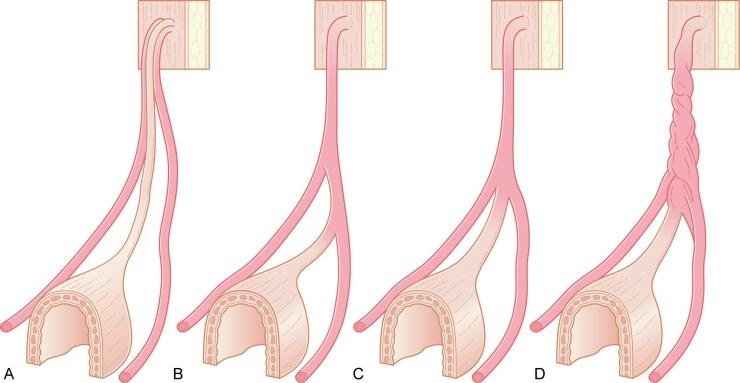
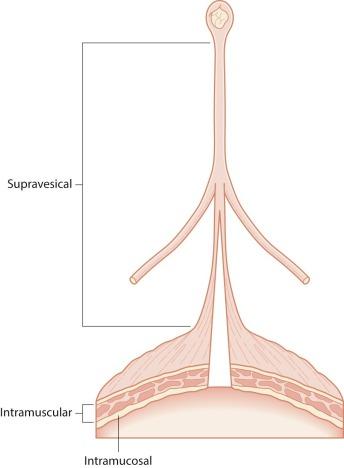
The urinary bladder is supplied by two pairs of vessels, the superior and inferior vesical arteries, branches from the internal iliac arteries. The lymphatics of the anterior and posterior bladder walls drain through the internal and middle chains of the external iliac lymph nodes, and those of the trigone drain to both the external iliac nodes and the hypogastric nodes.
The bladder is lined by a specialized epithelium variously referred to as urothelium for its adaptation to the urinary environment or transitional cells after the anal transition zone, a vestige of the cloaca, or because of its morphology, which early microscopists perceived as transitional between squamous and glandular. The designation urothelium is preferred here for its reflection of the function of these cells. The urothelial lining of the human urinary tract is composed of three to six layers of cells. The apparent number of layers varies with the degree of distention or stretching at the time of fixation. There are two subtypes of urothelial cells: the umbrella cells, which cover the surface and are in direct contact with urine, and the underlying cells, which comprise the other layers.
The umbrella cells (also referred to as superficial cells) are the largest cells of the urothelium ( Fig. 5.3 ) and have eosinophilic cytoplasm, which may contain small amounts of mucin. Their nuclei are large and often somewhat irregular with condensed hyperchromatic chromatin and inconspicuous nucleoli. Superficial (umbrella) cells are frequently binucleated and occasionally multinucleated. Ultrastructurally, umbrella cells have asymmetric cell membranes with a thick outer layer, an irregular angular surface resulting from insertion of stiff segments of membrane, and a variety of intercellular connections. These specializations enable the umbrella cells to cope with the rigors of the urinary environment and maintain the blood–urine barrier as the bladder expands and contracts. Superficial umbrella cells express uroplakins, GATA3, and CK20 on immunohistochemistry ( Fig. 5.4 ).
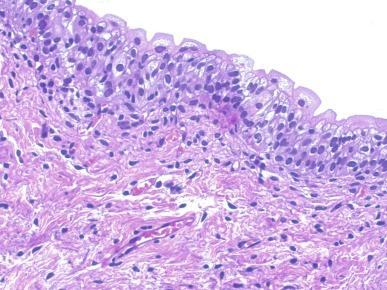
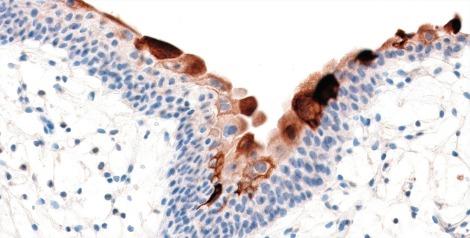
The urothelial cells of the other layers are smaller and more uniform than the umbrella cells, with pale cytoplasm. The nuclei are central, predominantly oval, and, in the deeper layers, oriented perpendicular to the basement membrane. Often there is a noticeable nuclear groove. The chromatin is very fine and evenly dispersed, and nucleoli are small and inconspicuous. Mitotic figures are uncommon, and DNA replication studies reveal that the urothelium is renewed approximately once a year. The epithelial cells of the basal layer express BCL2, whereas the intermediate cells express RB1 and PTEN at varying intensities. The basal layer of urothelium rests on a basement membrane, which can be highlighted with immunohistochemistry for laminin and type IV collagen. Beneath the basement membrane is the lamina propria, a zone of loose connective tissue that contains delicate vessels and thin, delicate bundles of smooth muscle fibers referred to as the muscularis mucosae ( Fig. 5.5 ). The muscularis mucosae of the bladder is variable, ranging from an essentially complete layer, analogous to that seen in the colon, to a sparse and incomplete array of smooth muscle fibers. In the bladder dome and trigone, the muscularis mucosae may become hypertrophic/hyperplastic, resulting in compact bundles of smooth muscle separated by stroma. In cases of bladder outlet obstruction (prostatic hyperplasia) the muscularis mucosae may become hyperplastic (compensatory hyperplasia) and disorganized with fibers splayed in different directions. The connective tissue beneath the muscularis mucosae contains an arcade of larger vessels ( Fig. 5.6 ). The lamina propria is usually thinner in the bladder neck and trigone. Beneath this is the muscularis propria , composed of large bundles of muscle fibers with a scant amount of loose connective tissue. The arrangement of muscle bundles varies in pattern and thickness at different locations in the bladder. Distinct layers, analogous to those of the bowel, are seen only in the area of the internal sphincter. In the bladder neck and superior urethral regions the muscle bundles are more uniform and densely packed than seen elsewhere. In the trigone the muscularis propria is located very superficially. Also, the interface between the muscularis propria and the perivesical soft tissue is often irregular, a finding that may cause difficulties in assessing microscopic invasion for staging purposes. A number of immunohistochemical stains have been applied in an attempt to differentiate muscularis mucosae from muscularis propria. Smoothelin, desmin, and vimentin have been reported to be differentially expressed in both. However, contradictory reports with overlapping results are on record. None is currently recommended in practice. Normal adipose tissue is present within the lamina propria and through all layers in the bladder wall.
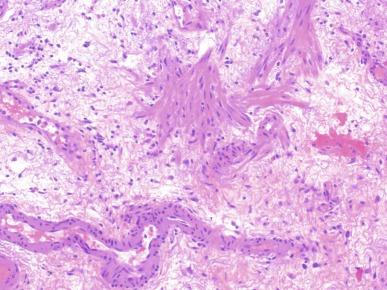
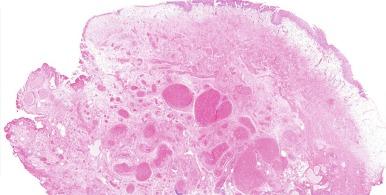
Histologically, urachal remnants typically consist of a central lumen lined by epithelium and surrounded by a narrow zone of dense connective tissue, then bundles of smooth muscle fibers, and finally a connective tissue adventitia ( Fig. 5.7 ). Such tubular remnants are present in about 33% of adults. Schubert et al. classified intramural urachal remnants into three groups, ranging from simple tubular structures to more complex canals ( Figs. 5.8 and 5.9 ).
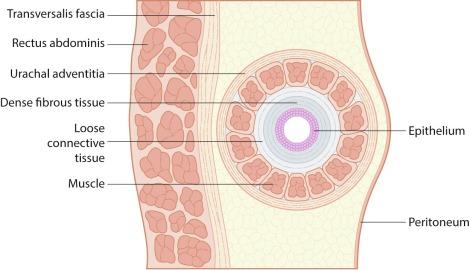
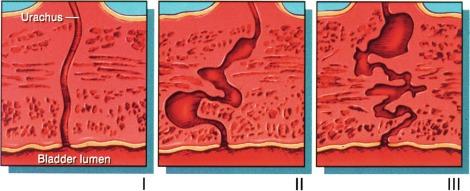
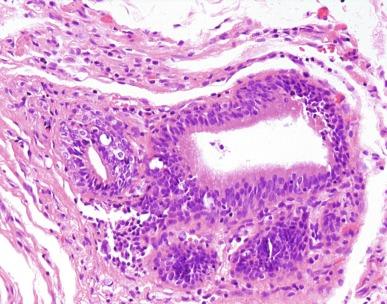
The mucosal segment of the urachus may consist of a papilla, a small opening flush with the surface, a wide diverticular opening, or may be absent ( Figs. 5.10 and 5.11 ). Hammond et al. found a mucosal opening in 10% of specimens. Blichert-Toft et al. found that the epithelial component was present in more than 50% of supravesical segments of the type I variant but was often absent or limited to the segment immediately above the bladder in type IV. Urothelium is the most common lining, present in more than 66% of intramural remnants. The remaining intramural remnants are lined by columnar cells that occasionally may be mucus-secreting. Rarely, remnants are lined by flattened epithelium, and some cases may not show covering epithelium.
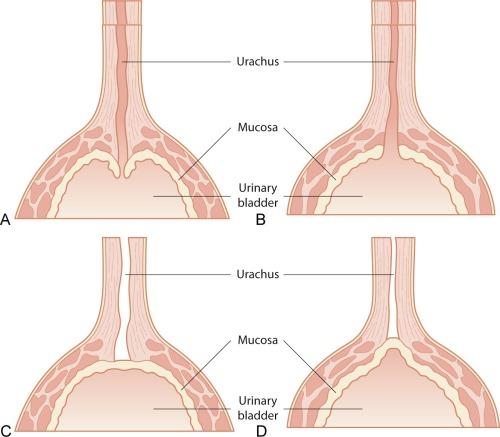
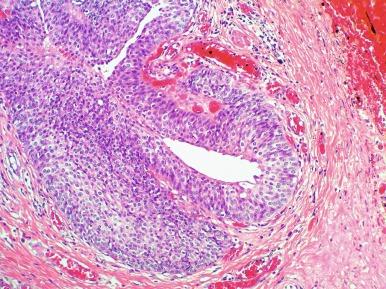
Well-circumscribed nests of urothelial cells in the lamina propria, von Brunn nests, arise by a process of budding from the overlying epithelium or by migration and may or may not be attached to the epithelium. Autopsy studies reveal von Brunn nests in 85% to 95% of bladders, most commonly in the trigone. Previously some considered these nests to be related to inflammation or a precursor of carcinoma, but neither view is currently accepted. Today they are viewed as normal features of the bladder mucosa.
Histologically, von Brunn nests are rounded, well-circumscribed groups of urothelial cells in the lamina propria, usually close to the urothelium but occasionally appreciably deep ( Fig. 5.12 ). Central lumina are often present within florid von Brunn nests, sometimes with cystic dilatation. Their regular shape and orderly spatial arrangement contrast with the features of rare carcinomas with a nested pattern that are occasionally confused with von Brunn nests. In contrast, small, crowded nests with variable spacing and an infiltrative base characterize the nested variant of urothelial carcinoma. The nuclei of the cells in von Brunn nests lack significant atypia. Reactive and metaplastic changes in the surface urothelium may also occur in von Brunn nests. Urothelial carcinoma in situ may extend into von Brunn nests and should not be mistaken for invasion of the lamina propria. When von Brunn nests are numerous, closely packed, and hyperplastic, the distinction from inverted papilloma may be difficult and arbitrary. Rarely, florid epithelial proliferations may occur in cases of von Brunn nests, like those seen in the setting of radiation or chemotherapy (see later discussion).
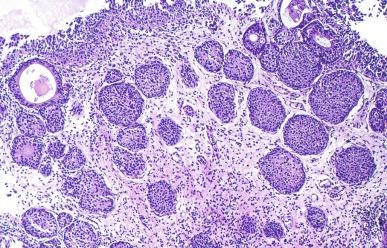
The existence of the typical and mucinous forms of cystitis glandularis have been recognized for many years, leading, however, to somewhat confusing terminology. The more common form can be referred to as typical or conventional type of cystitis glandularis, and the second form as the intestinal type. Cystitis glandularis of intestinal type is currently designated intestinal metaplasia. Molecular and immunohistochemical evidence of divergent pathways of histogenesis for these two metaplastic processes have been reported. Although the two lesions may coexist, one may predominate or be present exclusively.
The term cystitis glandularis refers to a lesion that evolves from and merges imperceptibly with von Brunn nests. Cystitis glandularis is so common that it may be considered a normal feature of the vesical mucosa. Autopsy studies reveal its presence in up to 71% of bladders, most commonly in the trigone. Most foci of cystitis glandularis are microscopic. However, it occasionally forms irregular, rounded, or nodular elevations of the mucosa. Exceptionally it forms larger polypoid lesions that may be mistaken for a neoplasm before microscopic examination. Microscopically, cystitis glandularis is composed of glands in the lamina propria that are lined by cuboidal to columnar cells surrounded by one or more layers of urothelial cells ( Fig. 5.13 ). Similar epithelium may also be present on the mucosal surface. The glands of cystitis glandularis may be dilated. Although the lining cells are sometimes characterized as mucinous, they usually do not appear overtly mucinous in sections stained with hematoxylin and eosin, and mucin stains are often negative or weakly positive. Cystitis cystica consists of von Brunn nests in which the central cells have degenerated to form small cystic cavities. Albeit somewhat less common than von Brunn nests and cystitis glandularis, cystitis cystica is present in up to 60% of bladders. It is most common in adults but also occurs in children. At cystoscopy, its cystic nature is usually apparent. Grossly, the lesions appear as translucent, submucosal cysts that are pearly-white to yellow-brown ( Fig. 5.14 ). Most are less than 5 mm in diameter, but rare examples measuring a few centimeters in diameter have been reported. The cysts contain clear yellow fluid. Microscopically, the cysts are lined by urothelium or cuboidal epithelium ( Fig. 5.15 ) and filled with eosinophilic fluid in which a few inflammatory cells are often present. Cystitis cystica et glandularis need to be differentiated occasionally from a microcystic variant of urothelial carcinoma. The presence of at least focal cellular atypia and invading nests deeper in the bladder wall would favor carcinoma. Recent TERT mutation analysis studies support cystitis glandularis as a benign reactive process.
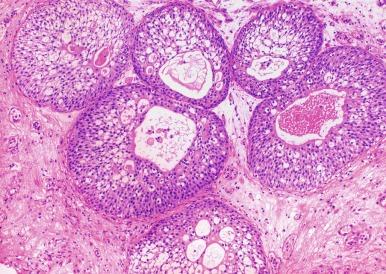
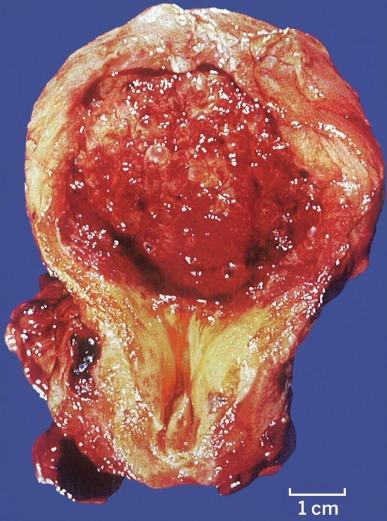
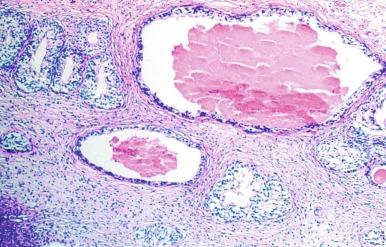
Cystitis glandularis and cystitis cystica are interrelated lesions in which cystitis cystica would be the end of spectrum with higher level of anomalies ( Fig. 5.16 ). In line with this thought, both lesions are frequently reported with the single term of cystitis glandularis et cystica. Cystitis glandularis and cystitis cystica have characteristic immunostaining with CK7, similar to normal urothelium, and lack expression of CDX2 and CK20, markers associated with intestinal differentiation.
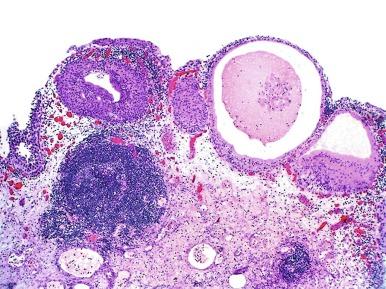
Intestinal metaplasia may be extensive, affecting both the lamina propria and the mucosa. The lining cells in intestinal metaplasia are tall and columnar with obvious mucin production. In such cases, goblet cells are often present, and the glands closely resemble colonic glands. Rarely, Paneth cells and argentaffin-, argyrophil-, or chromogranin A–positive cells are present. Biopsies from such areas closely resemble colonic mucosa, with tubular glands and numerous goblet cells ( Fig. 5.17 ). The mucin produced by these cells is of the colonic type. These lesions have characteristic immunostaining with CDX2 and CK20, and lack the expression of CK7. In some cases the cells also stain immunohistochemically with antibodies to prostate-specific antigen (PSA) and prostatic acid phosphatase (PAP).

Rarely, colonic epithelium may be present in the bladder as a developmental abnormality. Diffuse forms of intestinal metaplasia usually occur in chronically irritated bladders such as those of paraplegics or in patients with stones or long-term catheterization ( Fig. 5.18 ).
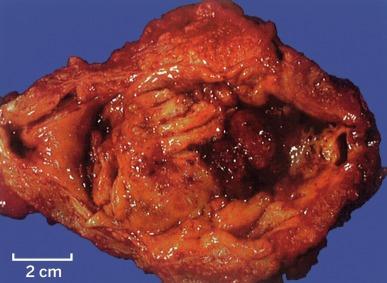
Intestinal metaplasia usually poses no diagnostic problem, but occasional cases are difficult to distinguish from adenocarcinoma, in particular florid extensive forms and cases showing a variable degree of dysplasia ( Fig. 5.19 ). Rare cases of intestinal metaplasia may coexist with mucin extravasation into the stroma, a finding not to be misdiagnosed as adenocarcinoma ( Fig. 5.20 ). Mitosis and cellular atypia are found only rarely in intestinal metaplasia. Intestinal metaplasia is typically confined to the lamina propria, with only rare cases extending superficially to the muscularis propria. Exceptionally, isolated glands of intestinal metaplasia may show moderate dysplasia in an analogous fashion to what is seen in colonic adenoma; the significance of this finding is uncertain. Nonetheless, suggested treatment is complete resection of the bladder lesion with close follow-up of the patient. It seems to be judicious to report these cases as intestinal metaplasia with adenomatous change, stating the level of dysplasia as a note. An irregular haphazard arrangement of glands in the lamina propria or deeper in the bladder wall with high degree of cytologic atypia should raise the suspicion of adenocarcinoma.
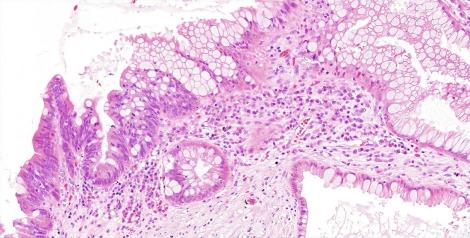
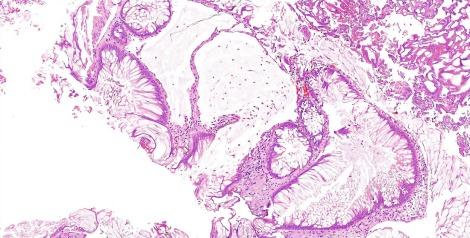
For many years there has been debate regarding the malignant potential of intestinal metaplasia. Sporadic reports describing the occurrence of adenocarcinoma in a background of longstanding intestinal metaplasia have led to speculation that intestinal metaplasia is a premalignant lesion. In support of this a recent study reported levels of telomere shortening in intestinal metaplasia consistent with a premalignant nature of this lesion. In contrast, no instances of bladder adenocarcinoma were identified in a study of 53 patients with intestinal metaplasia followed for more than 10 years, suggesting that intestinal metaplasia is not a strong risk factor for cancer.
Metaplastic squamous epithelium is common in patients with severe chronic cystitis such as nonfunctioning bladders or schistosomiasis. It is about four times more common in women than men. Squamous metaplasia may occur anywhere in the bladder but is most frequent on the anterior wall. Areas of metaplasia often are white or gray-white ( Fig. 5.21 ) and may blend into the surrounding mucosa or be sharply demarcated. Abundantly keratinizing lesions may have a bulky irregular appearance similar to carcinoma. Histologically, the lesions show squamous epithelium of variable thickness, often covered by a layer of keratin ( Figs. 5.22 and 5.23 ). In most cases there is no nuclear atypia, but changes as severe as those of carcinoma in situ are occasionally seen and should raise the possibility of invasive carcinoma elsewhere in the specimen or in nearby mucosa.
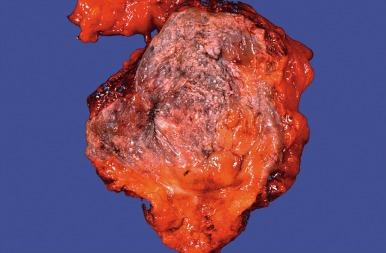
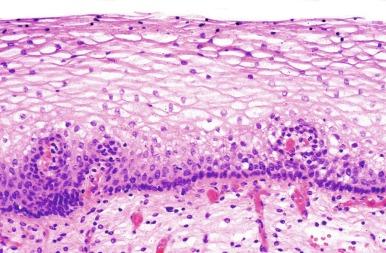
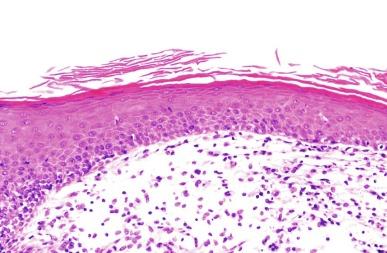
Keratinizing squamous metaplasia (leukoplakia) appears to be a significant risk factor for the development of carcinoma of the urinary mucosa. A Mayo Clinic study of 78 patients with keratinizing squamous metaplasia found that 22% had synchronous carcinoma and another 20% later had carcinoma (the mean interval was 11 years). Similar findings were reported by Khan et al. with a longer duration of follow-up. Most were squamous cell carcinoma. Where schistosomiasis is endemic, squamous metaplasia commonly precedes squamous cell carcinoma.
Nonkeratinizing glycogenated squamous epithelium, resembling vaginal epithelium ( Fig. 5.24 ), is present in the trigone and bladder neck in up to 86% of women of reproductive age and in almost 75% of postmenopausal women. This normal finding should not be diagnosed as squamous metaplasia. Cystoscopically, these areas are pale gray-white with irregular borders, often with a surrounding zone of erythema. The clinical association of this cystoscopic finding with symptoms of urgency and frequency has been called pseudomembranous trigonitis. This type of squamous epithelium is rare in men but has been reported in patients receiving estrogen therapy for adenocarcinoma of the prostate.
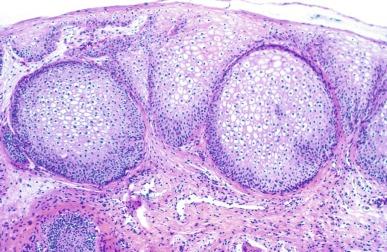
Verrucous squamous hyperplasia is a form of squamous metaplasia recently described to occur in the bladder, and consists of spiking or church spirelike squamous hyperplasia. The lesion presents with marked hyperkeratosis and elongation of the rete pegs. Occasional signs of maturation, such as focal granular cell layer, may be seen. It is considered a premalignant lesion with potential to evolve into verrucous or other forms of squamous cell carcinoma ( Fig. 5.25 ).
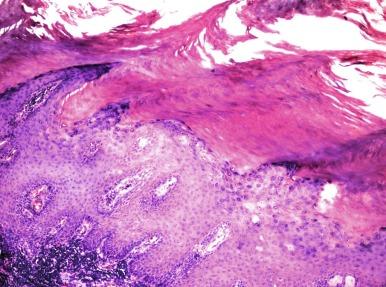
First described as a hamartoma in 1949 by Davis, the name nephrogenic adenoma was given a year later by Friedman and Kuhlenbeck in a report of eight cases. They chose this name because, in its most common form, the tumor is composed of small tubules resembling renal tubules. The terms nephrogenic metaplasia and adenomatous metaplasia are preferred by some. More than 75% of reported cases have involved the bladder, but lesions in the urethra, ureter, and rarely the renal pelvis have also been reported. Recent evidence in renal transplant patients suggests that nephrogenic adenoma is derived from tubular renal cells and is not a metaplastic proliferation of the urothelium as has long been thought. Molecular evidence suggests that clear cell adenocarcinoma of the bladder may rarely arise from nephrogenic adenoma.
Approximately 90% of patients with nephrogenic adenoma are adults, and there is a male predominance of 2:1. In children, it is more common in girls than in boys. Nephrogenic adenoma is frequently found after genitourinary surgery (61% of cases) or associated with calculi (14% of cases), trauma (9% of cases), and cystitis. Renal transplant recipients comprise about 8% of patients. Reports of hematuria, dysuria, and frequency are common, but the association with other lesions makes it difficult to categorically attribute any of these symptoms to nephrogenic adenoma.
Approximately 56% are papillary, 34% sessile, and 10% polypoid. It is rare on the anterior wall of the bladder, but nearly evenly distributed over the rest of the mucosa. About two-thirds are smaller than 1 cm in diameter, most being incidentally discovered microscopic lesions. Approximately 25% are from 1 to 4 cm in diameter, and only 10% are larger. In less than 20% of cases, there are multiple lesions, which rarely include diffuse involvement of the bladder.
Microscopically, nephrogenic adenoma displays tubular, cystic, polypoid, papillary, flat, fibromyxoid, and diffuse patterns. The most common architecture is tubular (present in 96% of cases). The tubules are typically small, round structures lined by cuboidal epithelium ( Fig. 5.26 ), but occasionally are elongated and solid. Sometimes they are surrounded by a prominent basement membrane. Cystic dilatation of the tubules is common ( Fig. 5.27 ) (present in 72% of cases) and may predominate. Tubules and cysts often contain eosinophilic or basophilic secretions, which may react with mucicarmine (present in 25% of cases). Polypoid and papillary structures ( Fig. 5.28 ) are present in 65% of cases. Edematous polyps are more common than delicate papillae, which are present in only 10% of cases. Focal solid growth ( Fig. 5.29 ) is uncommon. Rarely, a fibromyxoid stroma is present ( Figs. 5.30 through 5.32 ).
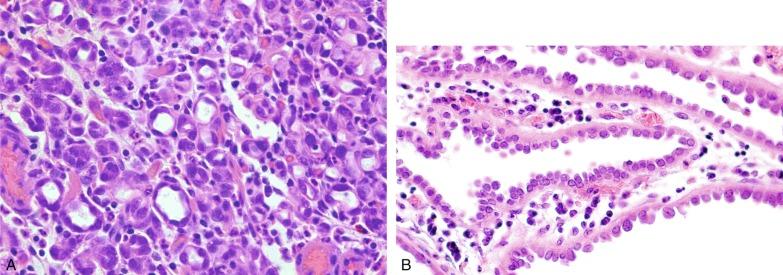
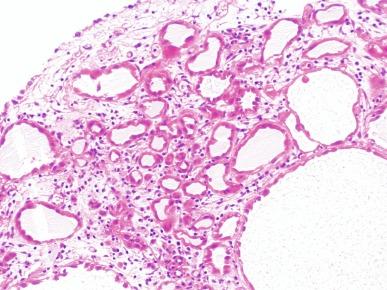
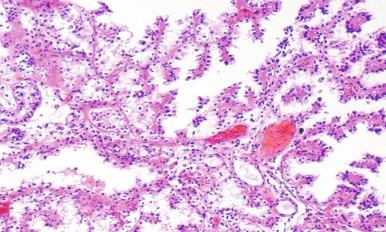

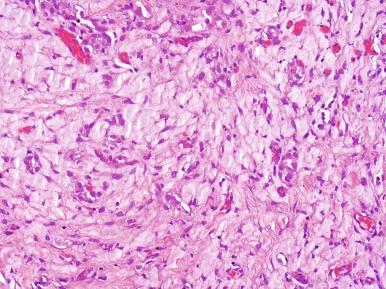
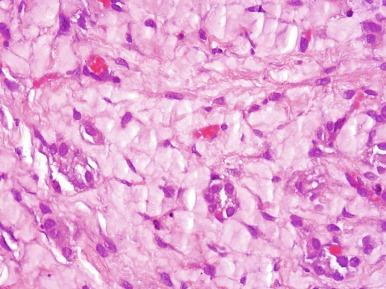
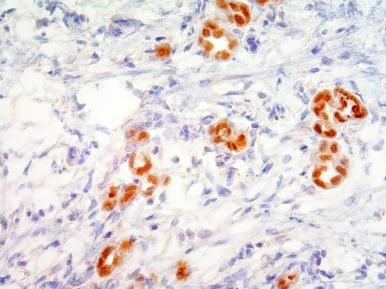
Most tubules, cysts, and papillae have cuboidal to low columnar epithelium with scant cytoplasm, but epithelium with abundant clear cytoplasm is seen in up to 40% of cases. Hobnail cells ( Fig. 5.26 B) focally line the tubules and cysts in 70% of cases, and rarely they predominate. Larger cysts may be lined by flat epithelial cells. Glycogen is present in some cells in 10% to 15% of cases. The nuclei are regular and round, and atypia is rare, usually appearing degenerative. Mitotic figures are absent or rare. Nephrogenic adenoma is often associated with chronic cystitis, which may obscure it. Rarely, it is associated with stromal calcification, squamous metaplasia, or cystitis glandularis.
Nephrogenic adenoma has a number of features that may cause confusion with bladder carcinoma. Tiny mucin-filled tubules apparently lined by a single cell with a compressed nucleus may resemble signet ring cells. The irregular disposition of the tubules may simulate invasive adenocarcinoma, especially when they are among the fibers of the muscularis mucosae. Hobnail cells may suggest clear cell adenocarcinoma, which shares architectural features of tubular, cystic, and papillary structures with nephrogenic adenoma (see Chapter 6 ). Clinical and pathologic features that help to distinguish nephrogenic adenoma from clear cell adenocarcinoma are listed in Table 5.1 .
| Feature | Nephrogenic Adenoma | Clear Cell Adenocarcinoma |
|---|---|---|
| Gender predominance | Male | Female |
| Age | 33% < 30 years | All > 43 years |
| Associated genitourinary conditions | Very common | Absent |
| Size | Usually small | Often large |
| Solid growth pattern | Rare | Common |
| Clear cells | Uncommon | Common |
| Glycogen in cytoplasm | Rare | Common and abundant |
| Hobnail cells | Common | Common |
| Necrosis | Absent | Often present (53%) |
| Luminal mucin | Common | Common |
| Nuclear atypia and mitotic figures | Rare | Common |
| Prostate-specific antigen | Negative | Negative |
| 34βE12 | Positive | Positive (occasionally negative) |
| CK7 | Positive | Positive |
| CK20 | Negative | Positive |
| EMA | Positive | Positive |
| AMACR (P504S) | Often positive | Often positive |
| PAX2 | Positive | Positive |
| PAX8 | Positive | Positive |
| Ki67-MIB1 labeling index (clone Ki67) | < 5% | Often > 15% |
| p53 | Occasional focal positive | Positive |
In a few cases of nephrogenic adenoma, papillae are the predominant feature ( Fig. 5.33 ); cytologic atypia may be present ( Figs. 5.34 and 5.35 ) and may cause confusion with other papillary lesions, such as urothelial carcinoma and papillary cystitis. Recognition of the cuboidal epithelium covering the papillae of nephrogenic adenoma differentiates it from these lesions, which are covered by urothelium.
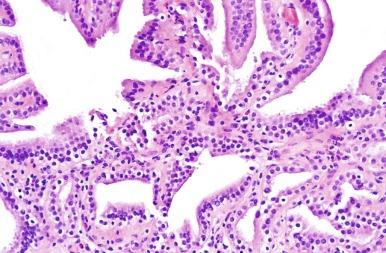
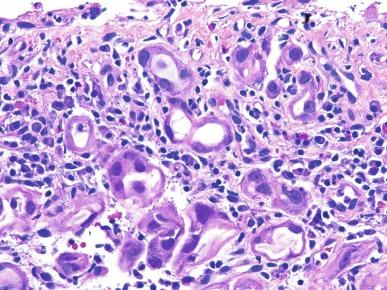

Nephrogenic adenoma may be confused with prostate adenocarcinoma because of immunoreactivity for racemase (P504S) and negative reactivity for basal cell–specific cytokeratin (34βE12) and p63. However, negative reactivity for PSA and PAP differentiates nephrogenic adenoma from prostate adenocarcinoma. S100A1 is also a useful marker to distinguish nephrogenic adenoma from prostatic adenocarcinoma. Immunohistochemical staining for nuclear transcription factors for renal development, PAX2 and PAX8, is useful for differentiating nephrogenic adenoma from prostate adenocarcinoma, benign urothelium, and papillary urothelial carcinoma. Focal GATA3 positivity has rarely been observed in nephrogenic adenoma. Pathologic features that favor clear cell adenocarcinoma over nephrogenic adenoma include the predominance of clear cells, severe cytologic atypia, high mitotic rate, the presence of tumor necrosis, high Ki67 count, and strong reactivity for p53.
The urothelial mucosa overlying inflammatory or neoplastic processes may occasionally have a papillary appearance on microscopic examination. In some cases, discovery of the bladder lesion precedes identification of the underlying condition, and in these cases the bladder lesion is referred to as a herald lesion. The term papillary hyperplasia is used when papillae are not seen grossly or at cystoscopy. Most often the underlying lesion originates in the prostate, female genital tract, or colon. When associated with prostatic disease, the papillary lesions are found in the trigone in the midline; those associated with uterine disease are found in the midline above the trigone. When associated with intestinal disease, the bladder lesions are often on the left and posterior. In this context, papillary hyperplasia is seen as a nonspecific reactive process. This reactive hyperplasia should be distinguished from the papillary urothelial hyperplasia that is seen as the earliest manifestation of papillary carcinoma, a lesion renamed by the current World Health Organization classification of the tumors of the urinary tract as urothelial proliferation of uncertain malignant potential.
Polypoid and papillary cystitis result from inflammation and edema in the lamina propria leading to papillary and polypoid mucosal lesions. The term papillary cystitis is used for finger-like papillae ( Figs. 5.36 and 5.37 ) lined by reactive urothelium and polypoid cystitis for broad-based edematous lesions ( Figs. 5.38 and 5.39 ). The latter are more common. Chronic inflammation in the lamina propria and dilated blood vessels are prominent and diagnostically helpful features of both papillary and polypoid cystitis. Depending on the degree of edema of the lamina propria, there is a continuous morphologic spectrum from papillary cystitis to polypoid cystitis to bullous cystitis ( Fig. 5.39 ). In papillary and polypoid cystitis the lesion is taller than it is wide, whereas in bullous cystitis the opposite applies. There may be associated metaplastic changes in the epithelium covering or adjacent to the lesion.
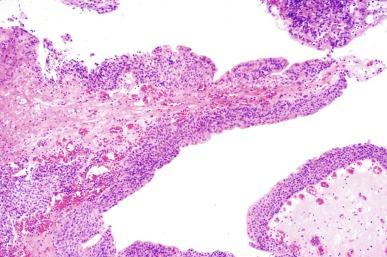
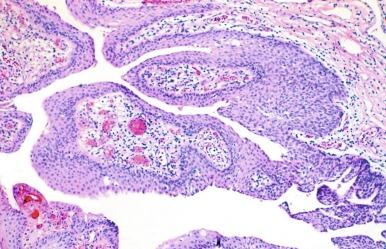
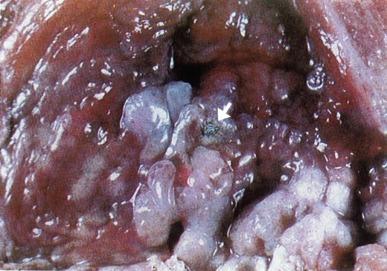
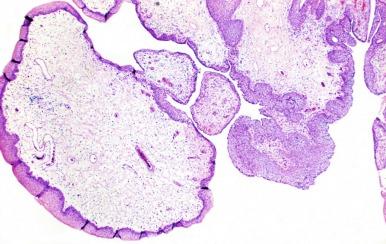
In the clinical settings of indwelling catheter and vesical fistula, the surgical pathologist should be alert to the possibility that an exophytic bladder lesion may be inflammatory. Polypoid cystitis is present in up to 80% of patients with indwelling catheters. Although most lesions are microscopic in size, polypoid or bullous lesions up to 5 mm in diameter (mostly in the dome or on the posterior wall) are found in about 33% of cases. Prolonged catheterization may induce widespread polypoid and bullous cystitis. Most lesions disappear within 6 months of removal of the irritant.
Vesical fistulae, whether resulting from intestinal diverticulitis, Crohn disease, colorectal cancer ( Fig. 5.40 ), or appendicitis, are often associated with polypoid cystitis and, less commonly, with papillary cystitis. Fistulae between the urinary bladder and the alimentary tract are about three times more common in men than in women. Pneumaturia and fecaluria are typical symptoms. In about 50% of cases, indications of extravesical disease are initially absent, making the diagnosis more difficult. Patients may present with frequency, urgency, and dysuria. Cystoscopically, the appearance often suggests bladder carcinoma.
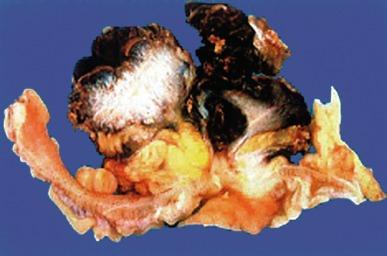
Papillary and polypoid cystitis must be distinguished from papillary urothelial carcinoma. Grossly and microscopically, the fronds of polypoid cystitis are much broader than those of most papillary carcinomas. The delicate papillae of papillary cystitis more closely resemble those of carcinoma. Branching is much less prominent in papillary cystitis than in papillary carcinoma. In papillary cystitis the epithelium may be hyperplastic, but usually not to the degree seen in carcinoma. Umbrella cells are more often present in papillary cystitis than in carcinoma.
Follicular cystitis occurs in up to 40% of patients with bladder cancer and 35% of those with urinary tract infection. Grossly, the mucosa is erythematous with pink, white, or gray nodules ( Fig. 5.41 ). Microscopically, the nodules consist of lymphoid follicles in the lamina propria, usually with germinal centers ( Fig. 5.42 ). Malignant lymphoma is the most important differential diagnostic consideration, particularly in biopsies. The criteria used to distinguish lymphoma from chronic inflammation at other sites apply here.

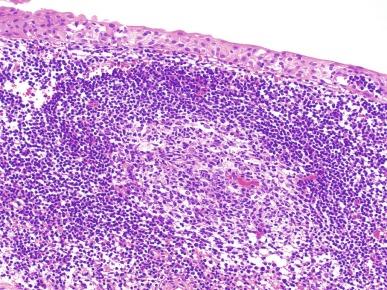
Atypical mesenchymal cells with enlarged, hyperchromatic, or multiple nuclei are frequently seen in the lamina propria of the bladder. Wells found them in 33% of cases of cystitis at autopsy and coined the term giant cell cystitis. Such cells are common in bladder biopsies including those without other evidence of cystitis. Histologically, the cells often have bipolar or multipolar tapering eosinophilic cytoplasmic processes ( Fig. 5.43 ). The nuclei are often irregular in size and shape and hyperchromatic. Mitotic figures are absent or rare. If present in large numbers, these cells may suggest pseudoneoplastic lesions such as postoperative spindle cell nodule and neoplasms such as sarcomatoid urothelial carcinoma or sarcoma. Similar cells may be seen in the lamina propria after radiation therapy and anticancer chemotherapy.
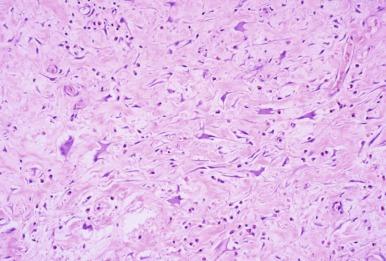
Cystitis with a predominantly hemorrhagic clinical presentation ( Fig. 5.44 ) may be caused by chemical toxins, radiation, viral infection, or may be idiopathic. Chemical causes include drugs (such as cyclophosphamide, busulfan, and thiotepa), derivatives of aniline and toluidine (such as dyes and insecticides), and a host of other compounds. Radiation and chemotherapy for cancer account for most cases.
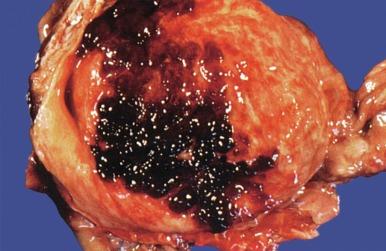
Since its introduction in the late 1950s, cyclophosphamide has been recognized as a potent bladder toxin associated with hemorrhagic cystitis. Hemorrhage may be severe, and early experience reported mortality of nearly 4%. Hemorrhage usually begins during or shortly after treatment. Within 4 hours the mucosa is edematous and congested ( Fig. 5.45 ), and the epithelium shows changes like those seen in the irradiated bladder, including nuclear pleomorphism and variable cell size. As the bladder heals the urothelium becomes hyperplastic and may form papillae. High doses of cyclophosphamide and repeated exposure may lead to irreversible fibrosis and a small contracted bladder. Epithelial and mesenchymal neoplasms may arise in the bladder after cyclophosphamide therapy.
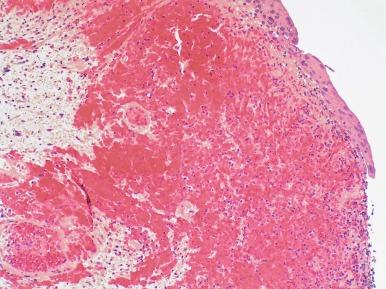
Interstitial cystitis has also been referred to as Hunner ulcer , but that term is used less frequently today because it has been recognized that ulcers are not always present. The term interstitial cystitis was introduced by Skene in 1887, and Nitze described most of the characteristic features before the work by Hunner in 1914. Interstitial cystitis poses diagnostic problems for both pathologists and urologists. The pathologic features are not specific, and the pathologist must correlate them with the clinical and cystoscopic features.
At least 90% of patients with interstitial cystitis are women, and it is seen most often in middle and old age. Patients report marked frequency, urgency, and pain when the bladder becomes full and when it is emptied. The urine is sterile. Cystoscopy may reveal small foci of hemorrhage (glomerulations), hemorrhagic spots that ooze blood, and linear cracks in the mucosa. Occasionally there are ulcers with radiating scars. Ulcers and scars are more frequent in older patients with long-standing cystitis. In advanced cases the wall of the bladder becomes fibrotic and contracted, resulting in very low bladder capacity ( Fig. 5.46 ). Interstitial cystitis most often affects the dome and posterior and lateral walls.
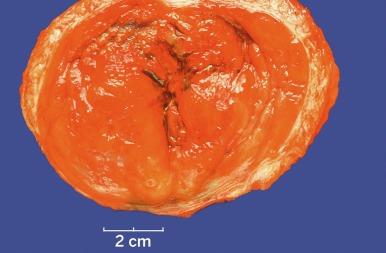
Biopsy specimens from patients with interstitial cystitis have a variety of appearances. When present, ulcers are often wedge shaped, and the urothelium is either absent or mixed with a surface exudate of fibrin, erythrocytes, and inflammatory cells ( Fig. 5.47 ). The ulcers usually extend deep into the lamina propria, which is edematous and congested. The muscularis propria may also be edematous or fibrotic. Generally, there is a dense infiltrate of lymphocytes and plasma cells. When ulcers are not present, the changes are less striking. Small mucosal ruptures, edema of the lamina propria, and foci of hemorrhage in the lamina propria are usually present and correspond to the glomerulations seen at cystoscopy ( Figs. 5.48 and 5.49 ).
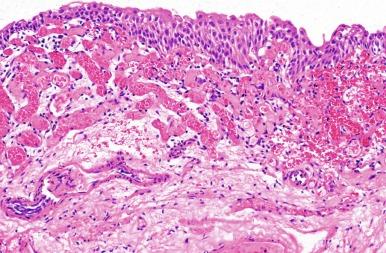
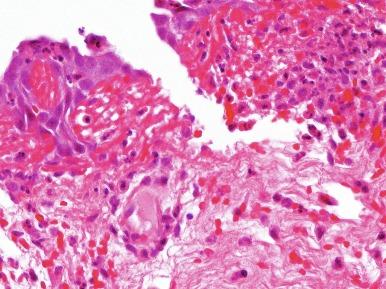
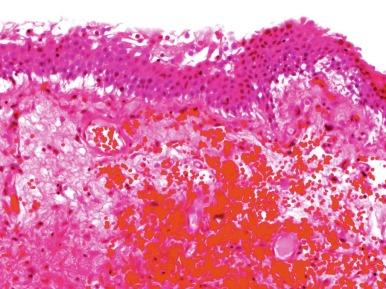
Mast cells are often seen in the mucosa, lamina propria, and muscularis propria in interstitial cystitis. Their significance has been debated since Simmons and Bunce first reported an increase in mast cells in interstitial cystitis in 1958. Kastrup et al. concluded that more than 20 mast cells/mm 2 in the muscularis propria was strongly suggestive of interstitial cystitis, and Larsen et al. found that 28 mast cells/mm 2 was the upper limit for normal bladders. Johansson and Fall found an average of 164 mast cells/mm 2 in the lamina propria of patients with ulcers, 93/mm 2 in those without, and 88/mm 2 in a control group. The difficulty of counting mast cells and the lack of consensus on what is “normal” are evident. Conditions of tissue fixation also affect the count. Thus the histologic features of interstitial cystitis are not pathognomonic and, therefore, the main indication of bladder biopsy in these patients is to exclude urothelial carcinoma in situ, a condition that may present with symptoms that overlap with those of interstitial cystitis.
The extensive urothelial denudation that often occurs with carcinoma in situ may result in an appearance of ulceration, inflammation, and vascular congestion closely resembling that seen in interstitial cystitis. When urothelium is absent or scant in a biopsy, multiple sections should be obtained to look for foci of atypical cells. Tamm-Horsfall protein is deposited in the epithelium and submucosa in patients with interstitial cystitis, indicating a barrier defect in this disease. When other conditions are excluded, often the pathologist can report only that the pathologic findings are consistent with interstitial cystitis.
Become a Clinical Tree membership for Full access and enjoy Unlimited articles
If you are a member. Log in here